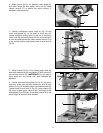
6
OPERATING CONTROLS
The following is an explanation of the operating controls of the Delta 10” Radial Saw. We suggest you study these
explanations carefully to familiarize yourself with the controls before turning on the power, to avoid damage to the saw
or personal injury.
A – TRACK ARM CLAMP KNOB. Controls swing of
track arm for all miter cutting operations. Locks track
arm at any angle for the full 360º rotation. To rotate track
arm loosen clamp knob and rotate arm. The arm will stop
at the 0º and 45º positions right and left. To move the
arm past these points the track arm index knob (B) must
be pulled out. (Fig. 2)
B – TRACK ARM INDEX KNOB. Locates 0º and 45º po-
sition, right and left, of the track arm. (Fig. 2)
C – YOKE INDEX LEVER. Locates each 90º position of
the yoke for ripping or cross-cutting operations. When
rotating the yoke the yoke clamp handle must first be
loose. (Fig. 2)
D – YOKE CLAMP HANDLE. The yoke clamp handle
must be loose when rotating the yoke to the rip or cross-
cut position. (Fig. 3)
E – ANTI-KICKBACK DEVICE. When ripping, the yoke
is positioned and clamped so that the blade is parallel to
the fence. The rear of the blade guard is lowered until it
almost touches the workpiece. The anti-kickback rod is
then lowered so that the fingers catch and hold the
workpiece. Never rip from the anti-kickback end of the
blade guard. (Fig. 3)
F – OVERARM ELEVATING HANDLE. Controls the
depth of cut in all operations. Turning the handle raises
or lowers the overarm. (Fig. 2)
G – CUTTINGHEAD CLAMP KNOB. Locks cuttinghead
at any position on the track arm. When ripping the
cutting clamp knob must be tight. (Fig. 3)
H – BEVEL INDEX KNOB. Locates 0º and 45º and 90º
positions of the motor when bevel cutting. When tilting
the motor for bevel cutting, the bevel clamp handle must
first be loose. (Fig. 3)
J – BEVEL CLAMP LEVER. Controls tilt of motor for
bevel cutting operations. Locks motor at any desired
angle on the bevel scale. (Fig. 3)
K – TABLE CLAMP KNOBS. Allows the operator to
quickly set the desired fence position. (Fig. 3)
L – ON-OFF SWITCH. Conveniently placed at eye level;
switch can be turned on or off in an instant for added
operator protection. (Fig. 3)
M – MITER SCALE. Indicates degrees left and right for
setting track arm. (Fig. 2)
Fig. 2
Fig. 3
A
C
M
B
F
L
E
H
J
D
G
K


















